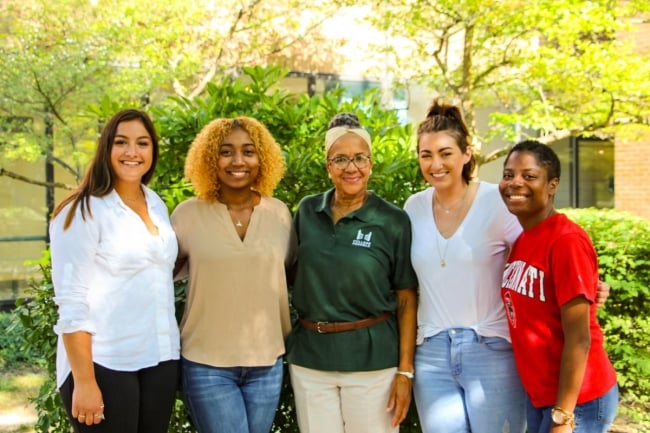You have /5 articles left.
Sign up for a free account or log in.

University of Cincinnati success coaches and their supervisor
Beth Vleaminck
Colleges and universities are seeing increases in year-to-year retention of low-income students after investing in a new program that pairs these students with alumni who mentor and support them throughout their college career.
Nine colleges and universities -- four private and five public institutions -- are taking part in the Catalyze program, created by College Possible, a nonprofit AmeriCorps organization focused on helping low-income students get admitted to, and graduate from, college through an intensive curriculum of coaching and support. The program, which launched in 2016, hasn’t been around long enough to measure four-year retention rates, but some partner institutions, such as Saint Cloud State University and Augsburg University in Minnesota, have seen positive yearly results and experienced a 12 percent average increase in retention rates of participating students from fall 2017 to fall 2018 compared to other low-income students not participating in the program, according to program administrators.
Catalyze partners with the institutions to match the students with recent graduates who coach them for up to six years.
Some partner institutions, such as the University of Cincinnati, haven’t been involved in the program long enough for a full year's analysis, said Lisa Holstrom, senior assistant dean of UC’s College of Arts and Sciences; the university is piloting the Catalyze program with more than 450 first-year students this academic year. The university did, however, see a 5 percent increase in semester-to-semester persistence from students assigned a coach from fall 2018 to spring 2019, compared to low-income first-year students from fall 2017 to fall 2018, Holstrom said. UC will receive 2018-19 results in September, she said.
She noted that UC has large numbers of students from low-income families; 28 percent of first-year students in fall 2018 were eligible for Pell Grants, a federal financial aid subsidy for students from low-income families. "So to us, 5 percent is a very big, desired improvement over where we were," she said.
The goal of Catalyze is to increase retention rates among students who are eligible to receive the federal grants, said Jim McCorkell, CEO and founder of College Possible.
“The first thing we’re measuring is what percentage of students return the very next semester,” he said. “With students from low-income backgrounds, the numbers are lower than you would think. Low-income students aren’t making it semester to semester. Some transfer to other institutions, while others stop going.”
Low-income students are less likely than their wealthier peers to complete degree programs at four-year universities, according to federal data released earlier this year on the socioeconomic statuses of postsecondary students. The data have long-term implications given the changing student demographics at American colleges and universities. The proportion of low-income students enrolled at all higher ed institutions grew from 12 percent in 1996 to 20 percent in 2016, according to a study by the Pew Research Center. As a result, colleges and universities are looking for new strategies to close the graduation gap between students from poor families and those from higher-income households, and efforts that provide support and "nudge" students to the finish line are growing in popularity.
College Possible's program has constructed a personal approach to nudging, enlisting “near-peer” AmeriCorps coaches, or mentors, who are hired by the institutions and trained by both College Possible and individual colleges, Kendra Krolik, Catalyze's senior director and general manager said in an email. Each coach is assigned to up to 120 Pell-eligible, first-generation college students identified by the universities as possibly showing signs of struggling in their first year, McCorkell said.
Coaches are ideally younger alumni who come from similar socioeconomic backgrounds as the student and have experience navigating campuses. The coaches help connect students with resources at the institutions, such as academic tutors, counseling services and organizations they may be interested in joining. The coaches also serve as point persons for any problems or barriers students may experience. The coaches also spend time navigating financial aid resources with students -- updating their financial information to ensure they receive federal aid, or searching and applying for additional scholarships and grants.
“There’s someone waking up in the morning, worrying about the nonacademic components that make up a student’s life,” Holstrom said. “We have great academic advising that does that work, but they can’t always address the holistic issues those students face.”
Alison Trimbur, a 2018 UC alumna with a political science degree, was a coach (UC calls them success coaches) during the summer after she graduated and the following 2018-19 academic year. She had a cohort of 120 students that she communicated with throughout that period, and she estimated that between 82 and 85 percent of them responded to her outreach.
Trimbur said her own family struggled financially for some time. Her parents were young when they had her -- her mother was 21 years old -- and neither had a college degree. Her family of four was living off of a combined $20,000-per-year income from her mother’s waitressing job and her father’s construction work, she said. Then her mother went to college and got a degree, and everything changed.
“After she went to college, our income jumped dramatically,” Trimbur said. “Seeing my mother’s income before her degree and after the degree really drew me to the work at College Possible -- in making sure every student gets their degree.”
Trimbur said the level of coaching she provided to students depended on the needs and wishes of individual students. Some students needed help managing their heavy course loads, but others faced unique challenges related to their financial status. For instance, many of the students were surprised by the everyday costs of going to college, because they weren't aware of how financial aid works. Some felt socially isolated when they couldn't afford to take part in some activities in which friends on campus from higher-income families were participating, she said.
Trimbur also helped students overcome unexpected roadblocks and move forward after experiencing personal or emotional crises. A few students had trouble finding affordable housing; one student was estranged from a parent who stole her identity.
One of the students Trimbur coached was Latasha Hamner, a sophomore majoring in digital media at UC's College of Arts and Sciences. While both of Hamner’s parents went to college, as did her older sister, her father’s death after an asthma attack left her mother in a tight financial spot.
“She definitely pushed me to do what is best for my future,” Hamner said of her mother. “She wanted me to get an education, but it was ultimately my choice. I knew I wanted to be in film, and at my high school we didn’t have any film classes, so I knew I needed to go [to college].”
Hamner, who graduated from Shroder High School in the Cincinnati Public School System, pays for her textbooks and tuition with a Cincinnati Pride Grant from the university. The grant provides financial aid for the city’s public school students, but it doesn’t cover the cost of living on campus, so Hamner had to search elsewhere for other grants and scholarships to cover her housing. Trimbur helped Hamner look for and apply for scholarships and helped her work on organizing her daily planner and creating and editing a résumé.
“I would definitely recommend people meet with the coaches, because it helped me get through college -- it’s a familiar face,” Hamner said. “For incoming freshmen, it’s good to know that somebody cares about you, that somebody’s here for you to help you get around campus. It also brings that connection with advisers, other organizations and resources.”
Trimbur lived near UC’s campus and spent lots of nights at the campus library working on her graduate course work and remaining on call for her students late into the evening. College Possible emphasized that coaches should try to meet face-to-face with students more than relying on digital communication, she said, but several students actually requested she use text messages to check in so they could reply when they had time.
“It was an ongoing process with each student,” Trimbur said. “I saw them grow as a person and gain a little confidence … My last day, students wrote notes saying how helpful I had been and how much they’ve changed over the year. All those little milestones meant a lot, because I knew in the long run how much it would mean to my students.”
Cincinnati has four coaches assigned to 114 students each this academic year. The program costs the university $110,000 -- $50,000 for the first coach and $20,000 for each subsequent coach, McCorkell said. Trimbur was paid a stipend of about $482 every two weeks, through AmeriCorps’ federal grant. The fees paid by the colleges go towards in-person and online training for the coaches and data collection and analysis from College Possible, Holstrom said.
The organization projects the cost of coaches will be offset by increasing the graduation rates of low-income students, which means more tuition dollars for the university, McCorkell said. Holstrom said profits aren’t the primary goal of UC’s partnership. The university’s “moral imperative” is to get more low-income students to graduate, she said, but the university does anticipate a return on the investment.
“It’s an exciting opportunity to be able to increase grad rates and have the university be able to afford it,” McCorkell said. “It creates more paying customers -- from their point of view … if you even retain a couple of students, you will have covered the cost of the efforts, and most likely you’re going to retain more than one or two [students].”








